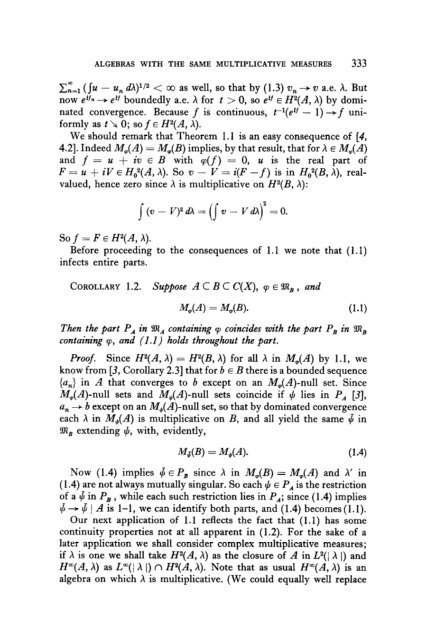On the Characters and the Plancherel Formula of Nilpotent Groups ...
On the Characters and the Plancherel Formula of Nilpotent Groups ...
On the Characters and the Plancherel Formula of Nilpotent Groups ...
You also want an ePaper? Increase the reach of your titles
YUMPU automatically turns print PDFs into web optimized ePapers that Google loves.
ALGEBRAS WITH THE SAME MULTIPLICATIVE MEASURES 333<br />
Cz==, ( J’u - u, dh)1/2 < co as well, so that by (1.3) v, -+ v a.e. h. But<br />
now et/n --+ en boundedly a.e. X for t > 0, so eIf E H2(A, h) by domi-<br />
nated convergence. Because f is continuous, t-l(e”f - 1) + f uni-<br />
formly as t L 0; so f E H2(A, A).<br />
We should remark that Theorem 1.1 is an easy consequence <strong>of</strong> [4,<br />
4.21. Indeed M,(A) = M+,(B) im pl ies, by that result, that for h E M,+,(A)<br />
<strong>and</strong> f = u + iv E B with y(f) = 0, u is <strong>the</strong> real part <strong>of</strong><br />
F = u + iV E H,2(A, X). So v - V = i(F -f) is in H,2(B, h), real-<br />
valued, hence zero since h is multiplicative on H2(B, A):<br />
J-(v- V)vh=(jv- q2=0.<br />
So f = F E H2(A, h).<br />
Before proceeding to <strong>the</strong> consequences <strong>of</strong> 1.1 we note that (1.1)<br />
infects entire parts.<br />
COROLLARY 1.2. Suppose A C B C C(X), q~ E %JIB , <strong>and</strong><br />
J%(A) = %W (1-l)<br />
Then <strong>the</strong> part PA in 1131, containing q~ coincides with <strong>the</strong> part PB in %I&,<br />
containing y, <strong>and</strong> (1.1) holds throughout <strong>the</strong> part.<br />
Pro<strong>of</strong>, Since H2(A, X) = H2(B, X) for all A in M,(A) by 1.1, we<br />
know from [3, Corollary 2.31 that for b E B <strong>the</strong>re is a bounded sequence<br />
{a,} in A that converges to b except on an M,(A)-null set. Since<br />
M,(A)-null sets <strong>and</strong> M,(A)-null sets coincide if $ lies in PA [3],<br />
a, + b except on an M&A)-null set, so that by dominated convergence<br />
each X in M,(A) is multiplicative on B, <strong>and</strong> all yield <strong>the</strong> same I,J in<br />
‘9JlB extending #, with, evidently,<br />
~$P) = ~,W. (I-4)<br />
Now (1.4) im pl ies 6 E PB since h in i&(B) = M,(A) <strong>and</strong> h’ in<br />
(1.4) are not always mutually singular. So each z+5 E PA is <strong>the</strong> restriction<br />
<strong>of</strong> a 4 in PB , while each such restriction lies in PA; since (1.4) implies<br />
$ -+ $ j A is l-l, we can identify both parts, <strong>and</strong> (1.4) becomes (1.1).<br />
Our next application <strong>of</strong> 1.1 reflects <strong>the</strong> fact that (1.1) has some<br />
continuity properties not at all apparent in (1.2). For <strong>the</strong> sake <strong>of</strong> a<br />
later application we shall consider complex multiplicative measures;<br />
if h is one we shall take H2(A, h) as <strong>the</strong> closure <strong>of</strong> A in L2( / A 1) <strong>and</strong><br />
H”(A, h) as L”(j h 1) n H2(A, h). Note that as usual H”(A, A) is an<br />
algebra on which A is multiplicative. (We could equally well replace

















